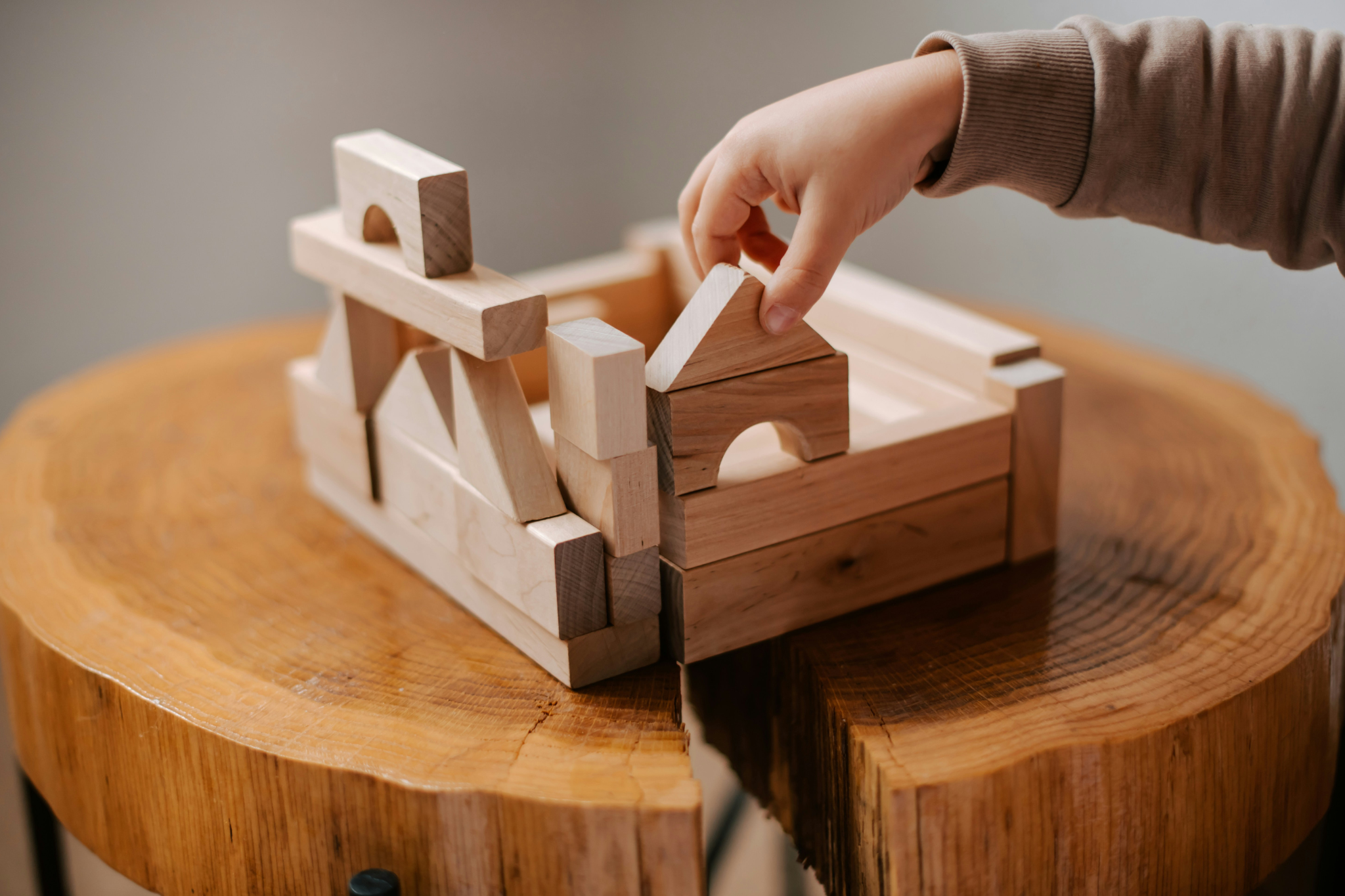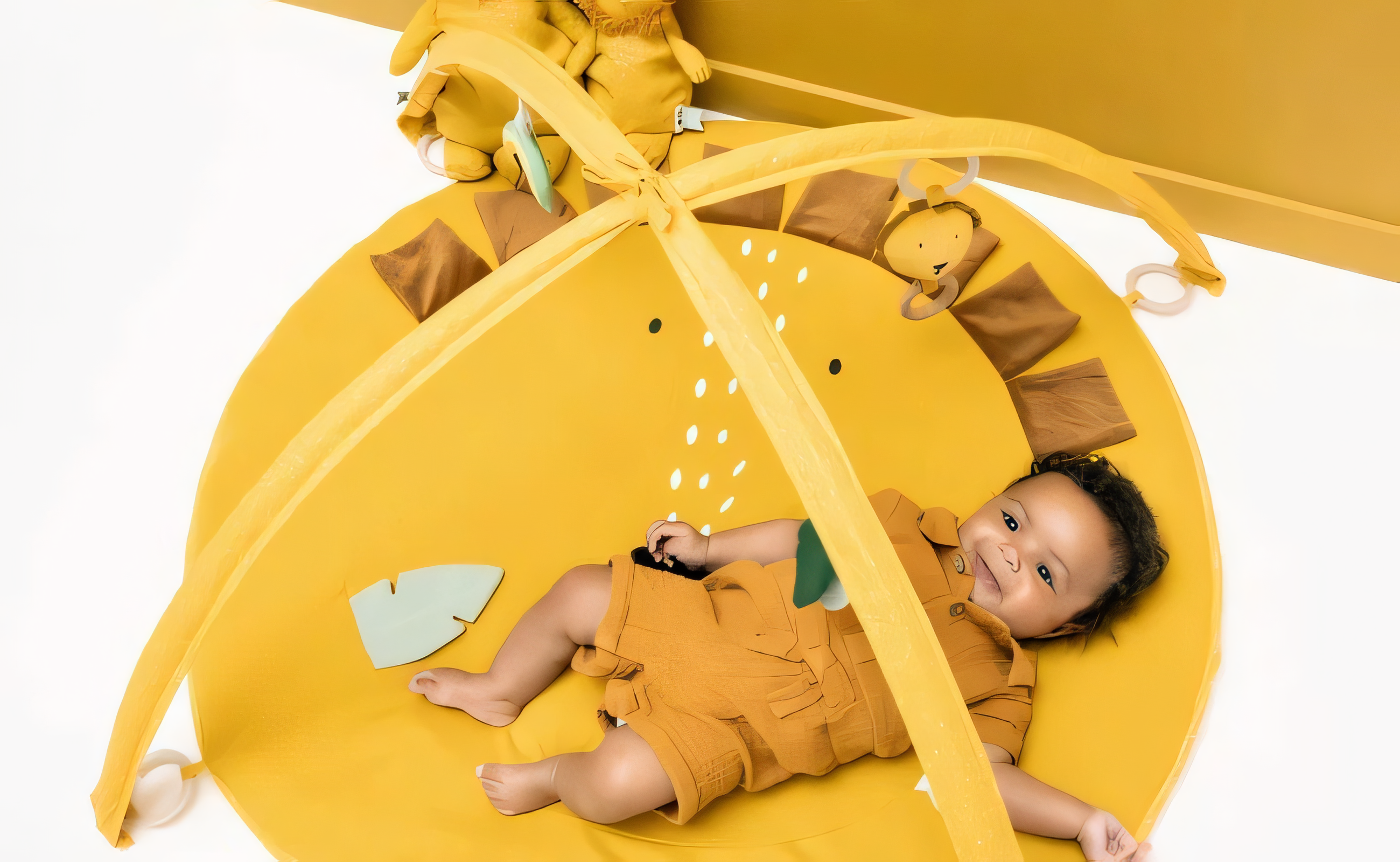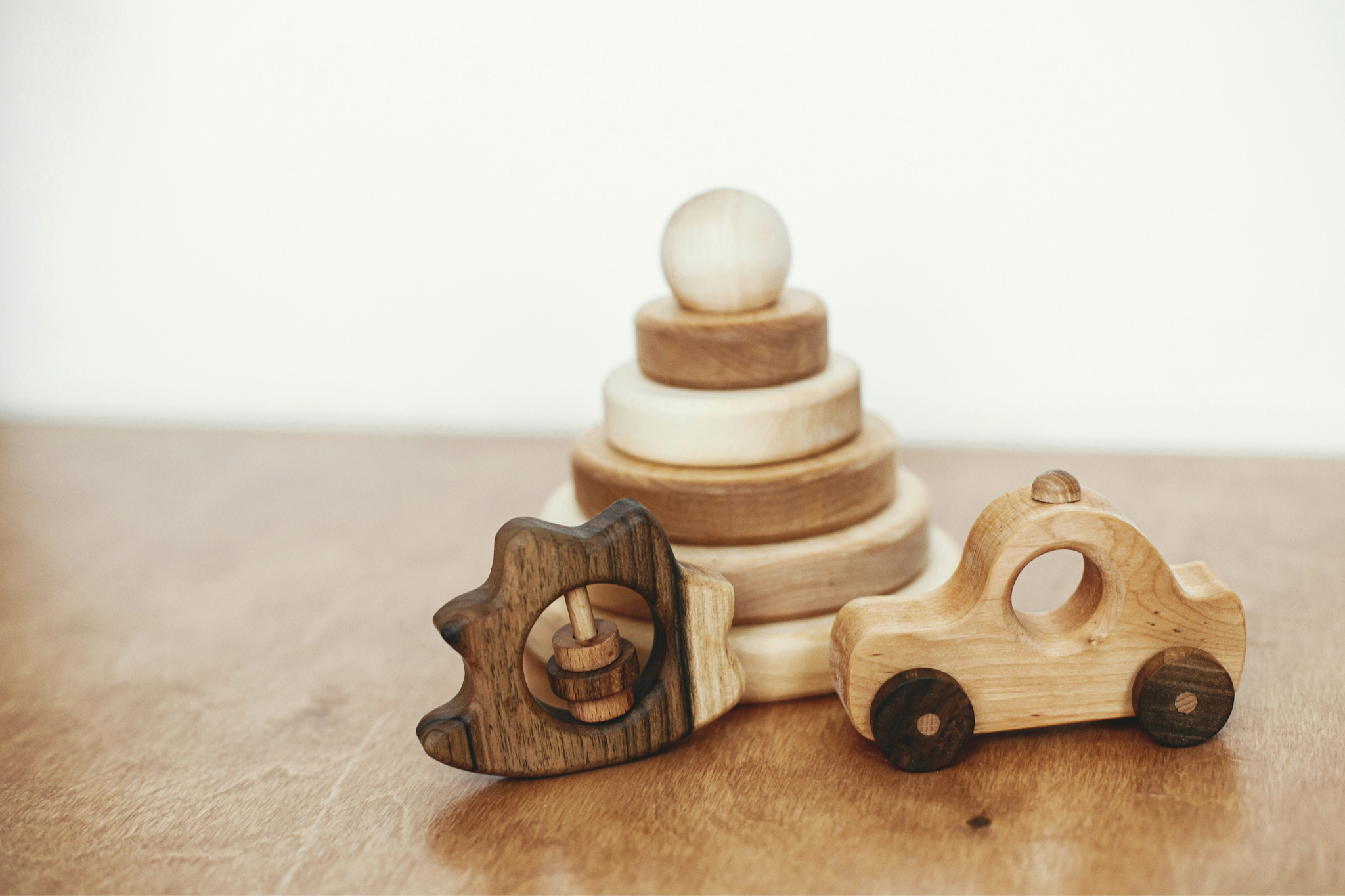Article: Fewer toys, more imagination: How a clean environment nourishes a child's creativity.

Fewer toys, more imagination: How a clean environment nourishes a child's creativity.
It's a scene every parent is familiar with. A room wallpapered in color, chests overflowing with plastic and plush treasures, shelves laden with promises of fun. And yet, amidst this abundance, a small voice echoes, as simple as it is disconcerting: "I'm bored."
The paradox is right there before our eyes. Never have our children owned so many objects designed to stimulate and entertain them, and yet their ability to create their own play, to occupy themselves alone in a peaceful silence, sometimes seems to be diminishing. Faced with this observation, our first instinct is often to offer them a new toy, an additional distraction.
What if the solution was not to add, but rather to subtract with intention?
This article isn't a manifesto against play—quite the opposite. It's an invitation to rediscover the power of what's essential. Together, let's explore how a simpler, more refined environment doesn't deprive your child, but offers them the greatest gift of all: a fertile space for their own imagination to finally flourish.
The Paradox of Abundance: When Too Many Toys Kills Play
Behind every toy that enters the home, there is a good intention. A birthday present to make eyes sparkle, a small purchase to console a sorrow, or simply the desire to offer the best to stimulate the awakening of one's child. We want to give them the world, and we often materialize it by an accumulation of objects supposed to represent it. Yet, by observing carefully, we touch on a counterintuitive truth: in the realm of play, abundance is not always synonymous with wealth. On the contrary, it can become an invisible obstacle to the blossoming of creativity.

The Illusion of Choice: Overstimulation in Question
Imagine yourself in front of a buffet offering a hundred different dishes. Your most likely reaction isn't gluttony, but paralysis. Overwhelmed by the options, you might nibble at a little bit of everything without enjoying anything, or simply feel overwhelmed. A child's brain, still developing, reacts similarly to a sea of toys.
The brain is a wonderful sponge, but it is not a hard drive with unlimited capacity. Faced with a floor littered with stimuli—a car here, a doll there, an unfinished puzzle, an open book—it enters a state of overstimulation. Unable to make a calm choice and stick to it, the child flits about. He grabs a car, rolls it for two seconds, abandons it for a light brick, which is itself abandoned for a figurine. Each object is a potential interruption, a call that diverts his attention from the previous one.
In this incessant ballet, deep play—the kind that builds concentration, patience, and problem-solving skills—simply doesn't have time to take hold. The child remains on the surface of things, never plunging into the immersive worlds that only sustained attention can create.
The "toy show" versus the real game
This overabundance is often compounded by the very nature of modern toys. We live in the era of the "toy-show": it is often noisy, bright, and promises very precise interaction. It sings three songs, recites the alphabet, rolls along a predefined path. While seemingly sophisticated, it is in reality extremely creatively impoverished.
This type of toy dictates the story instead of letting it be born. It engages the child in a monologue where they become the spectator of the object's performance. The game is already contained within the toy; there is nothing to invent, only to activate. Once the three songs are known by heart and the mechanism understood, the object loses all its interest and joins the graveyard of forgotten toys in a corner of the room.
At the opposite end of the spectrum is the "silent toy," the open-ended toy. A basket of wooden cubes, silk scarves, expressionless animal figurines, or even a simple cardboard box. Their strength lies in their simplicity. They offer nothing, and that's why they allow everything. A wooden cube isn't just a cube: it's by turns a telephone, a birthday cake, a car, a brick to build a castle. Its silence is an invitation. Its simplicity is a direct call to the imagination, which must then get to work giving it life, a role, a story.
The invisible consequences on the child
This overabundance of objects, especially when they are directive, is not without consequences. It discreetly shapes the child's habits. The first victim is concentration, eroded by constant flitting. The second is creativity itself, which becomes "assisted": the child learns to wait for the toy to provide distraction, rather than drawing it from within.
Finally, and perhaps most insidious, it fuels an addiction to novelty. The thrill no longer comes from the deep exploration of a familiar object, but from the superficial excitement provided by the next toy. Pleasure shifts from "play" to "acquisition," setting up a cycle of desire and rapid weariness. Far from enriching him, this ocean of possibilities can end up drowning his most precious play instinct: the one that comes from within.
Emptiness as a Backdrop: The Science Behind Creativity
If abundance overwhelms, one might fear that emptiness will create anxiety or lack. This is a legitimate fear in our societies, which value "more." Yet, when it comes to child development, it's quite the opposite. A purified space is not a space devoid of meaning; it's a space filled with potential. It's silence that allows music to exist, the blank page that invites poetry.
Rehabilitating Boredom: The True Starting Point of Imagination
In our culture of performance and constant stimulation, we've learned to view boredom as a failure. A bored child is a problem to be solved, a void to be filled as quickly as possible with an activity, a screen, or a new object. We've forgotten that boredom isn't an absence, but a transition. It's an essential state of mental decompression, the incredibly fertile ground where the seeds of creativity begin to germinate.
When the mind is no longer bombarded with external stimuli, it turns inward. It begins to wander, to observe the details of a room, to remember a story, to connect ideas that a priori had nothing in common. It is in this apparent silence that the child's little inner voice begins to be heard. The sigh of "I'm bored" is often only the prelude to a brilliant idea. A chair becomes a cabin, a shadow on the wall becomes a monster to be tamed, three pieces of string become a pirate's treasure. To intervene too quickly is to nip this creative impulse in the bud. To trust boredom is to trust in your child's innate ability to be the author of their own adventures.
An environment that respects the child's rhythm
This idea is not a passing trend, but a wisdom rooted in the great pedagogies of the 20th century. Maria Montessori, for example, spoke of the importance of a "prepared environment" ( l'ambiente preparato ). An orderly, simple, and beautiful environment, where each object is carefully chosen and has a defined place. This external order, she said, helps the child build his or her internal order, concentration, and autonomy. A limited number of quality objects, accessible and tidy, allows the child to make conscious choices rather than being the plaything of his or her environment.
Similarly, Waldorf-Steiner education has always valued simple toys, made from natural materials, with undefined shapes and expressions. A doll with a barely sketched face can be happy, sad, or sleepy, depending on the story the child projects onto it. It leaves plenty of room for the imagination, whereas a doll with a fixed smile and blinking eyes imposes its own character. These approaches, although different, share a fundamental conviction: to learn to think for themselves, the child needs mental and physical space.
The room like a blank page
Ultimately, providing a clean environment for your child is a bit like offering a blank page to a writer or a blank canvas to a painter. A page already covered with sentences and images leaves no room for writing. A canvas already painted cannot accommodate a new vision. Creative potential is annihilated by overflow.
A child's bedroom is not just a storage room for their possessions; it is the workshop of their mind, the stage for their inner theater. Every missing object is an added possibility. Every empty corner of wall, every square meter of cleared floor is not a lack; it is a space to be filled, a landscape to be invented. By offering this sobriety, we send them a powerful message: "I don't need to fill you with things, because I know you are already full of worlds."
Perfect. After establishing the why, we come to the how. This third part is the practical heart of the article. This is where we take the parent by the hand to show them that this philosophy is not only desirable, but also attainable.
Here is the construction of this third part.
“Choose Less, Better”: Creating a Fertile Gaming Ecosystem
The vision of a clean, uncluttered environment that fuels the imagination is inspiring, that's for sure. But the reality of a room filled with gifts, keepsakes, and impulse buys can seem like a mountain to climb. How do you move from theory to practice without turning this project into a source of conflict or frustration?

The answer lies not in a drastic, authoritarian purge, but in a conscious and gradual approach, guided by our founding philosophy: choose less, but choose better. It's not about depleting, but about cultivating. Here's a three-step method, designed as a gentle journey for you and your child.
Step 1: Observe before acting, the key to a smooth transition
Before moving or removing any object, the first action is the simplest: do nothing. Simply observe. For a week, become the benevolent anthropologist of your child's play. Sit back and take mental notes. Which toys do they spontaneously and repeatedly reach for? Which ones allow for long, calm, and immersive play? Which ones are grabbed for a minute before being abandoned? Which ones are, in reality, never touched?
This silent audit is incredibly rich. It often reveals that a small handful of toys constitute the true heart of the child's activity, while a large majority are merely visual "background noise." This step is crucial because it depersonalizes the sorting: it is no longer your tastes or your projections that decide, but your child's real affinities.
Step 2: The art of rotation, or how to re-enchant the familiar
The goal isn't to throw things away, but to create clarity. Toy rotation is a disarmingly effective technique for achieving this. Once you've identified your "star" toys and your "core" toys, the principle is simple:
-
Select about ten toys from among your child's favorites. Make sure to offer some variety (a building set, figurines, a puzzle, drawing materials, etc.).
-
Display them in an airy and accessible way on shelves or in baskets.
-
Store the others out of sight in boxes or cupboards.
Every two or three weeks, "swap" a few toys from the stockpile with those that are freely available. The magic happens instantly. The little train that had become invisible out of habit becomes an exciting novelty again. This method helps reduce overstimulation in everyday life while giving the impression of renewed abundance. It also subtly teaches the child that an object can continue to exist even when we can't see it.
Step 3: The “good toy” checklist, your compass for choosing
Whether you're sorting through your existing inventory or guiding your future choices, it's helpful to have a compass. A "good toy" isn't necessarily the most expensive or the trendiest, but the one that leaves the most room for the child. Here are three questions to ask yourself:
-
Is it versatile and "open"? A good toy is 90% the child and 10% the object. It doesn't dictate its use. This is the case with timeless classics: building blocks, animal or simple character figurines, fabrics and scarves, modeling clay, musical instruments... They can be reinvented endlessly.
-
Is it made of noble and sustainable materials? The quality of a toy can be felt by the touch. A wooden object (PEFC certified, for example, for sustainable forest management) is not only more robust; its warmth, weight, and texture offer a richer sensory experience that invites care and respect. Favoring materials like wood, organic cotton, wool, or natural rubber means choosing objects that live and age well.
-
Does it allow them to connect with reality? Children learn by imitating the world around them. Toys that allow them to reenact everyday scenes are essential. A small play kitchen to "be like Mom and Dad," adapted gardening tools, a doctor's kit, or simple dolls help them understand and integrate into the adult world, while developing their empathy.
By following this path, you're not just decluttering a room. You're transforming it into a fertile play ecosystem, where every object has a purpose and the largest playground reverts to what it should never have ceased to be: your child's imagination.
Our selection to feed the imagination
Moving from theory to practice means choosing objects that don't impose their story, but invite you to create one. Each toy we select is designed as a tool for the mind, a raw material for adventure. Here are three essentials that embody this philosophy.
1. The Fundamental Cubes in Solid Wood A soaring tower, a bridge spanning an imaginary river, an enclosure for animals... Their radical simplicity is a blank page offered to the mind. They don't indicate how to play; they pose a question. The contact of the certified wood (PEFC), soft and warm, anchors the game in a sensory and natural experience, far from the over-stimulation of plastic.
2. The Natural Colors Play Arch More than just a stacking game, it's an exploration of balance and harmony. The arches become tunnels, doll cradles, waves on the ocean carpet, or poetic sculptures. They intuitively teach notions of size, nesting, and physics, transforming logic into creative discovery.
3. The Forest Animal Family The fox, the bear, the deer... More than just toys, these are the silent characters of great imaginary adventures. Their deliberately sleek design and one-piece wooden construction leave plenty of room for your child's personality. They are the perfect actors for developing language, empathy, and storytelling.
Explore all our awakening essentials
The Gift of Trust
At the end of this journey, the image of the overflowing room appears in a new light. What might have seemed like a sign of love and generosity turns out to be a potential barrier to what we want most for our children: their ability to flourish on their own. We have seen that too many toys can paralyze play, that boredom is the breath of creativity, and that material order promotes clarity of mind.
So, decluttering, choosing, simplifying... These actions are not deprivations. They are profound acts of trust. It's about betting that our child's inner wealth is infinitely greater than any collection of objects. It's about whispering to them, through our actions, that we believe in their ability to create, invent, and inhabit the world with their own resources.
By offering him less, we are not offering him emptiness, but space. Space to think. Space to be bored and, from this boredom, to give birth to a universe. Space to observe a single object from all angles, to discover its texture, its weight, the thousand and one lives it can contain. We are offering him the long time of deep play, the opposite of the short time of distraction.
Ultimately, the greatest gift we can give our children is not to fill their room, but to give them the keys to build their own worlds.




